3D body scanning, full-body scanning, and human body 3D scanners
What is 3D body scanning?
3D body scanning is the action of capturing in 3D the human body using a 3D body scanner.
3D body scanners can capture a human body, or only specific parts, to generate a very detailed 3D model within a few seconds. The result is a 3D model of the body or limb which was captured.
Depending on the desired application and on the 3D body scanner used, the 3D model can feature colors and textures to perfectly match the original person. It can also simply be a mesh, a sort of cloud of dots that form the body’s shape.
3D body scanners are revolutionizing the way we capture, measure, and track evolutions of the human body, in various fields from medical to fitness or entertainment. Recent improvements in whole-body 3D scanning technologies are leading to a growing number of applications.
Initially developed for the clothing industry, 3D body scanners are greatly improving our ability to accurately measure and visualize a person’s body size, shape, and skin-surface area. Recent advances in whole-body scanning unlock new potential, especially for healthcare applications.
What are the benefits of 3D body scanning?
3D body scanning is the perfect technology to capture in 3D a full human body or specific parts. When compared to traditional body imaging and measurement technologies, 3D body scanning offers many benefits.
Non-invasive
3D body scanning is an entirely non-invasive process. The 3D scanner never physically touches the subject.
In the case of handheld 3D scanners, the device is held at a certain distance by the operator, who moves around the subject.
In the case of a 3D scanning booth, the subject simply stands in the middle of the booth to be captured in 3D from all angles by a number of sensors, all without direct physical contact.
Fast
Scanning a person with a 3D scanning booth takes less than 10 seconds. When using a portable 3D scanner, the process can take several minutes and requires the subject to stand perfectly still.
Accurate
3D body scanners are high-precision tools and usually boast high resolution to produce highly detailed 3D models. They can detect things the human eye can’t, making such 3D scanners very valuable in many circumstances.
The quality of the result depends of course on the type of body scanner being used. Some 3D scanning booths are capable of capturing several people at once with a stunning level of details, including colors and textures.
The top 3D body scanning applications
3D body scanning can have many applications. Among them, the most common are:
3D figurines
Also called 3D selfies or 3D portraits, 3D figurines are miniature statues of actual people. They are typically 3D printed from a 3D model obtained with a full-body 3D scanner, usually a 3D scanning booth. Full-color 3D printers are required to achieve such prints.
Fitness and body shape monitoring
3D body scanners are used in fitness to track the progress of a person through various body measurements, body shape metrics, posture analysis, and more.
Fashion and clothing
The Fashion industry is starting to use 3D body scanners to capture accurate body measurements in order to make custom and tailored apparel.
In retail, 3D body scanning unlocks new potential for in-store and online shopping with the emergence of virtual fitting rooms. Shoppers can use their own 3D avatar based on accurate body measurements to try on new clothes effortlessly.
Healthcare and medical
There are many applications of body scanning in medical fields, from monitoring a patient’s body shape to identify potential issues, to capturing highly detailed 3D models of body parts such as a disabled limb to make custom prosthetics, for example.
3D body scanning can also help monitor how fast a burn is healing by capturing in 3D the damaged skin, identifying the burnt tissues, and measuring the area to track progress thanks to colors and textures 3D scanning.
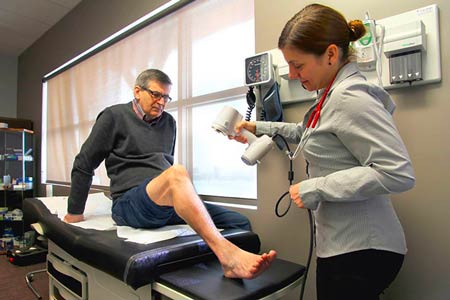
Avatar creation
3D body scanning and 3D face scanning can be used in the entertainment industry to create realistic avatars, for use in video games, for example.
The best 3D body scanners and body scanning booths
Body scanning booths and full body 3D scanners
3D scanning booths are cabins rigged with 3D scanners or sensors. The person stands in the middle and holds still for a few seconds in order for the body scanner to capture images from all angles. The body scanner then generates a detailed 3D model of the person.
There are several types of 3D scanning booths:
- Closed 3D scanning booth or closed body scanner: A circular cabin rigged with cameras or 3D scanners, allowing the subject in the center of the booth to be captured in 3D from a 360° angle.
- Full-body 3D scanners: The subject stands on a rotating turntable facing a vertical 3D scanner. During the 3D body scanning process, the turntable rotates to allow the subject to be fully captured in 3D from all angles. The body scan is generated when the full, 360° rotation is complete.
The two main 3D scanning technologies used in body scanning are:
- Photogrammetry: A fast 3D capture process consisting of taking many pictures of an object at once and from different angles, then processing them through an algorithm to “stitch” them together and generate a 3D model. Photogrammetry technology delivers high-quality, colored, and textured body scans.
- Structured light: A series of linear light patterns are cast on an object. The 3D scanner then generates an accurate 3D model using triangulation. This 3D scanning technology is highly accurate but requires the subject to be very still.
The two technologies can also be used in combination.
Portable and handheld 3D scanners
Handheld 3D scanners offer more flexibility than 3D scanning booths, as they can be carried around the subject to perform a body scan.
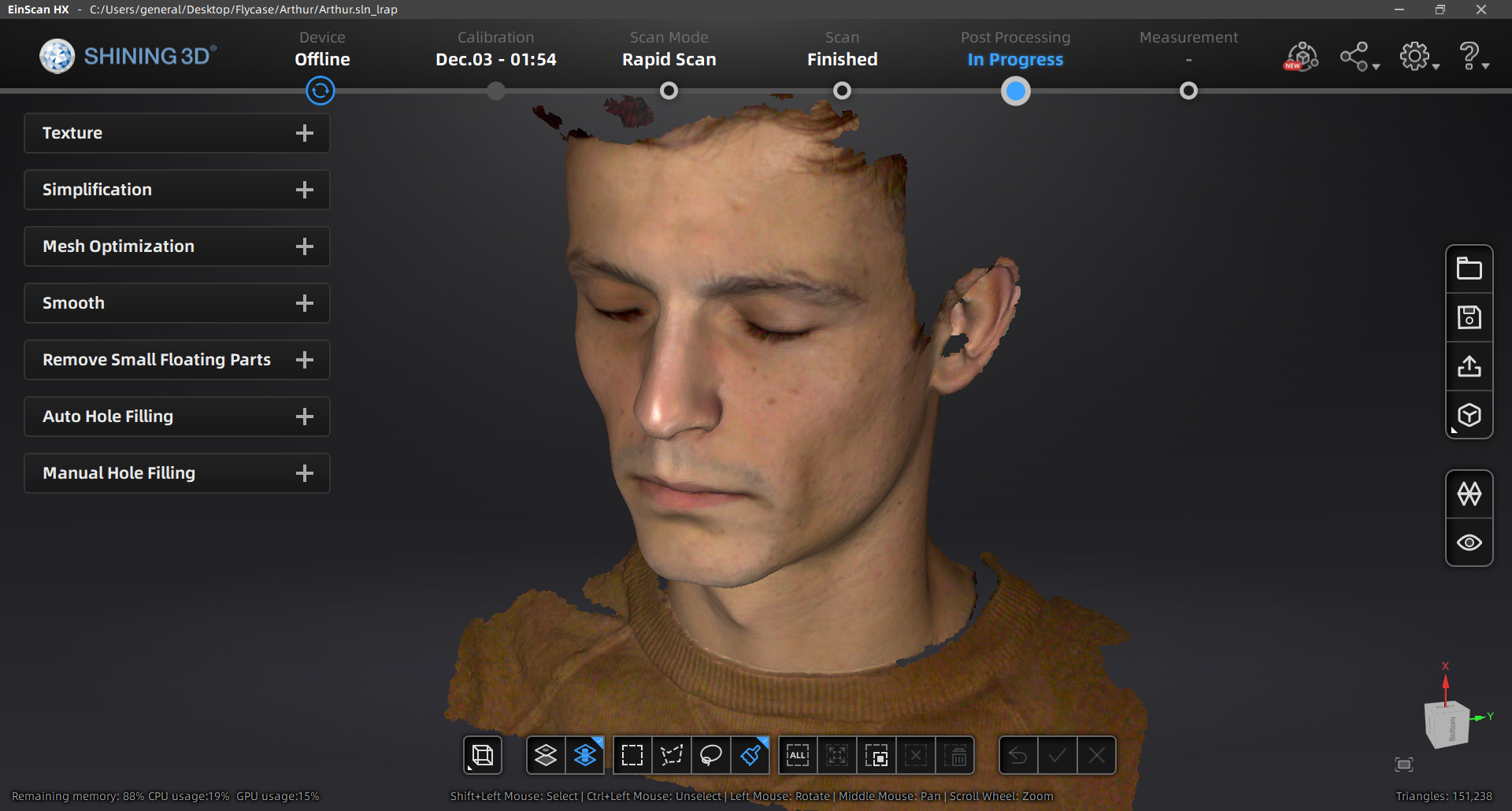
The downside is that the person being 3D scanned must remain completely still during the entire capture process; otherwise, the 3D scan is unusable. For this reason, in 3D body scanning applications, portable 3D scanners are typically used to capture body parts or limbs and not to perform full 3D body scans.
Some manufacturers specifically target their handheld 3D scanners at body scanning applications, like Shining 3D’s EinScan H.
3D body scanning for healthcare and medical applications
3D body scanners are getting increasingly used in the medical sector. Thanks to their non-invasive and fast way to capture the human body in 3D, whole-body 3D scanners are a perfect fit for applications in healthcare.
3D body scanners serve four major applications in the medical field.
Epidemiology
This is the study of the distribution and determinants of health-related states in specified populations. 3D body scanners can be used to do anthropometric surveys. For example, a study on the evolution of obesity amongst children.
3D full-body scanners are perfectly adapted to 3D capture many individuals in a short amount of time, enabling for example to obtain a meaningful sample for a study.
Diagnosis
Three-dimensional body scanning can help doctors make a diagnosis. For this type of use case, 3D scanners are mainly used to treat skin-related problems (burns, diseases, infections, wrinkles, …) and detect deformities through the analysis of the patient’s body captured in 3D.
Treatment
3D body scanners can be the difference between life and death for burn patients. To give the right amount of medicine to the patient, the amount of burnt skin needs to be perfectly calculated. Indeed, the drug quantity to deliver depends on the skin’s surface area; if the drug quantity isn’t perfectly dosed, the patient could suffer severe complications.
High-precision 3D body scanners or handheld 3D scanners can help accurately measure damaged skin surfaces.
Monitoring
Full-body 3D scanners can help monitor the changes in a patient’s body (shape, composition, etc.), for example in the case of a diet or during pregnancy. Body scanners are a new tool to help doctors and practitioners better track the evolution of their patients’ body metrics, thus allowing for more accurate diagnoses and recommendations.
Creating custom 3D printed prosthetics with 3D body scanning
Prosthetics are a great fit for 3D printing because they are mostly made of plastics and require to be customized to perfectly fit the patient. With 3D printing, it is now possible to make affordable prosthetics.
There are several open-source 3D models of prosthetics that have been developed by online communities such as The Open Hand Project. Voluntary designers and researchers join forces and collaborate, aiming to make prosthetics more affordable and better-fitted to the patients, especially kids whose prosthetics need to be upgraded regularly as they grow older and bigger.
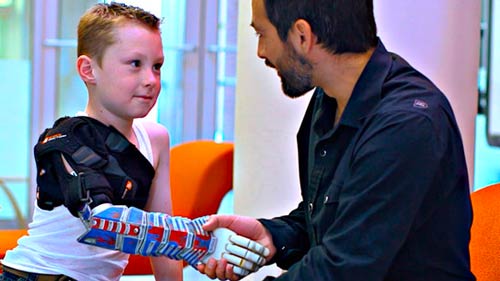
3D models of such prosthetics can be downloaded for free and then modified to perfectly fit each patient, then 3D printed on a desktop 3D printer.
How can 3D scanning help create 3D printed prosthetics?
In order to make the 3D printed prosthetics perfectly fit the patient’s limb, the first step is to perform a 3D scan of the area where the prosthetic will be attached.
Using the resulting 3D model, the 3D design of the prosthetic is to be adjusted to accurately match the stump’s shape, thus making the prosthesis more comfortable, durable, and performant.
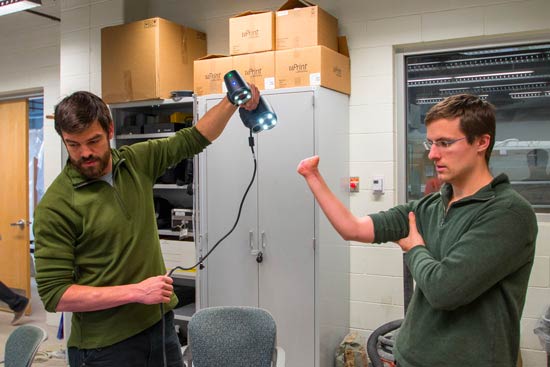
In such cases, a portable 3D scanner is typically chosen over a body 3D scanner, as there is no need for a full-body 3D scan.
3D body scanning for 3D printed figurines and 3D selfies
3D figurines, also known as 3D selfies, 3D portraits, or “mini-me’s” are 3D printed miniature figurines representing a person. Some call this 3D photography.
With the improvement of 3D scanning and 3D printing technologies, it is now possible to create such accurate 3D printed figurines, perfect as a gift or souvenir of an important life event, for instance.
Their are two steps involved in making a 3D portrait.
1. 3D body scanning the person
The person must first get 3D scanned, using a full-body scanner that can capture colors and textures. The best 3D scanners for 3D figurines are specifically designed 3D scanning booths.
The result is a highly detailed, colored, three-dimensional model of the person.
2. 3D printing the model
A few 3D printers are able to 3D print in color (they are called full-color 3D printers) but they are usually quite expensive and complex to operate.
That’s why most 3D figurine businesses resort to 3D printing vendors specialized in full-color 3D printing. The 3D model is sent to the 3D printing service which will print it and ship it to the end customer.

3D selfies make great presents and are perfect souvenirs for special occasions (weddings, graduations, …).
What is the best full-body 3D scanner for 3D printed figurines?
The process of making a 3D figurine starts with a 3D body scan. Such full-body 3D scans can be achieved either with a portable 3D scanner or with a 3D scanning booth.
In the case of 3D figurines, we strongly recommend the 3D scanning booth option, as the subject only has to hold the pose for a few seconds to get 3D scanned. Such booths are rigged with 3D scanners to capture the subject from all angles at once, with a very high resolution, colors, and textures.
With handheld 3D scanners, the human body 3D scanning process can take several minutes and the subject must remain completely still the entire time (a challenging feat for children or pets!). In both cases, the 3D model obtained is processed through a specific 3D software then sent for 3D printing.
3D body scanning for fitness
Body measurement and fitness tracking using a 3D body scanner
3D body scanners can capture and monitor data about the human body. Full-body scanners can indeed capture thousands of data points on a human body and provide personalized reports and tracking. Body scanners are becoming popular in gyms and fitness centers, or even at home where they can be used almost as a personal coach.
With razor-sharp accuracy and 3D imaging capacities, 3D body scanners can help fitness enthusiasts track their progression and achieve their goals (weight loss, muscle build, etc.). Three-dimensional body scanning can also provide information about posture, body composition (fat vs muscle percentage), and body shape.
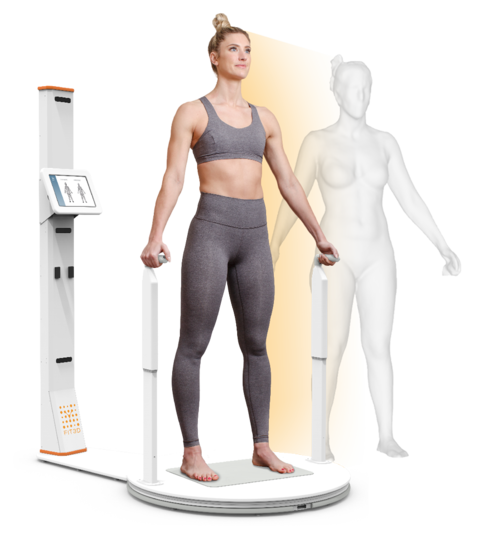
The body scanner becomes a fitness tracker and collects data points on a regular basis to show the user’s progression via 3D animated clips of the body shape, for example. It is important to note that such body scanners for fitness applications are usually not capable of capturing textures and colors, as they focus on body shape only.
The US company Fit3D developed the Proscanner, a 3D body scanner specifically designed for fitness tracking and comprehensive wellness assessment in gyms. They already are a fixture in gyms and fitness centers all over the world.
3D body scanning for fashion and the clothing industry
Creating virtual fitting rooms with 3D body scanning
A 3D body scan offers a precise 3D mapping and rendering of a person’s body. It can be used to create virtual fitting rooms where shoppers can easily visualize how pieces of apparel would fit on them, without actually having to wear them.
Some apparel retailers already make the most of virtual fitting rooms using 3D body scanning technology. The concept is simple: users create a profile based on their full-body scan. They can then virtually try on items from their home or from the in-store 3D body scanning booth.
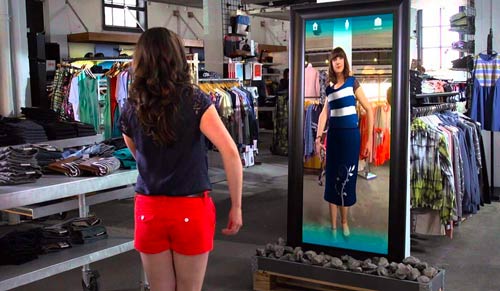
Virtual fitting rooms have a lot of potential in e-commerce since they can allow online shoppers to virtually try on clothes from the comfort of their home and make sure the size is right before purchasing, thus reducing the return rate.
Digital body measurement with 3D body scanners
3D body measurement can allow tailors and fashion brands to:
- Save time in the traditionally manual body measurement process
- Gather more accurate data on body measurements to create best-fitting shirts and suits.
By capturing in 3D all necessary data points for accurate body measurement in an instant, 3D body measurement systems or body scanning booth gives the opportunity to create custom-fit clothes more efficiently.
The company Acustom Apparel uses digital measuring 3D technology to gather every measurement and size from their customers and design custom-fitted attires. The company developed its own digital measuring technologies to gather around 2 million data points to create their customers’ 3D models. Based on this data and the customer’s personal preferences, an entirely tailored garment is created.
Create your own personalized avatar with 3D body scanning
3D body scanners can be used to create realistic avatars. In specific industries, such as retail or entertainment, avatars created with 3D scanning technology are meant to improve the customer experience.
For example, shoppers can use their own 3D avatar to virtually try on clothes instead of doing it physically.
Avatars are also heavily used in video games thanks to 3D face scanning, for example; in-game characters could look like the players themselves, for a more personalized and immersive gaming experience.
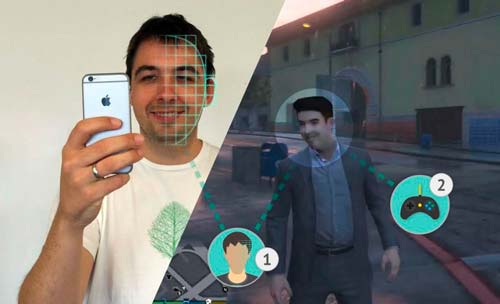
 English
English  Français
Français

